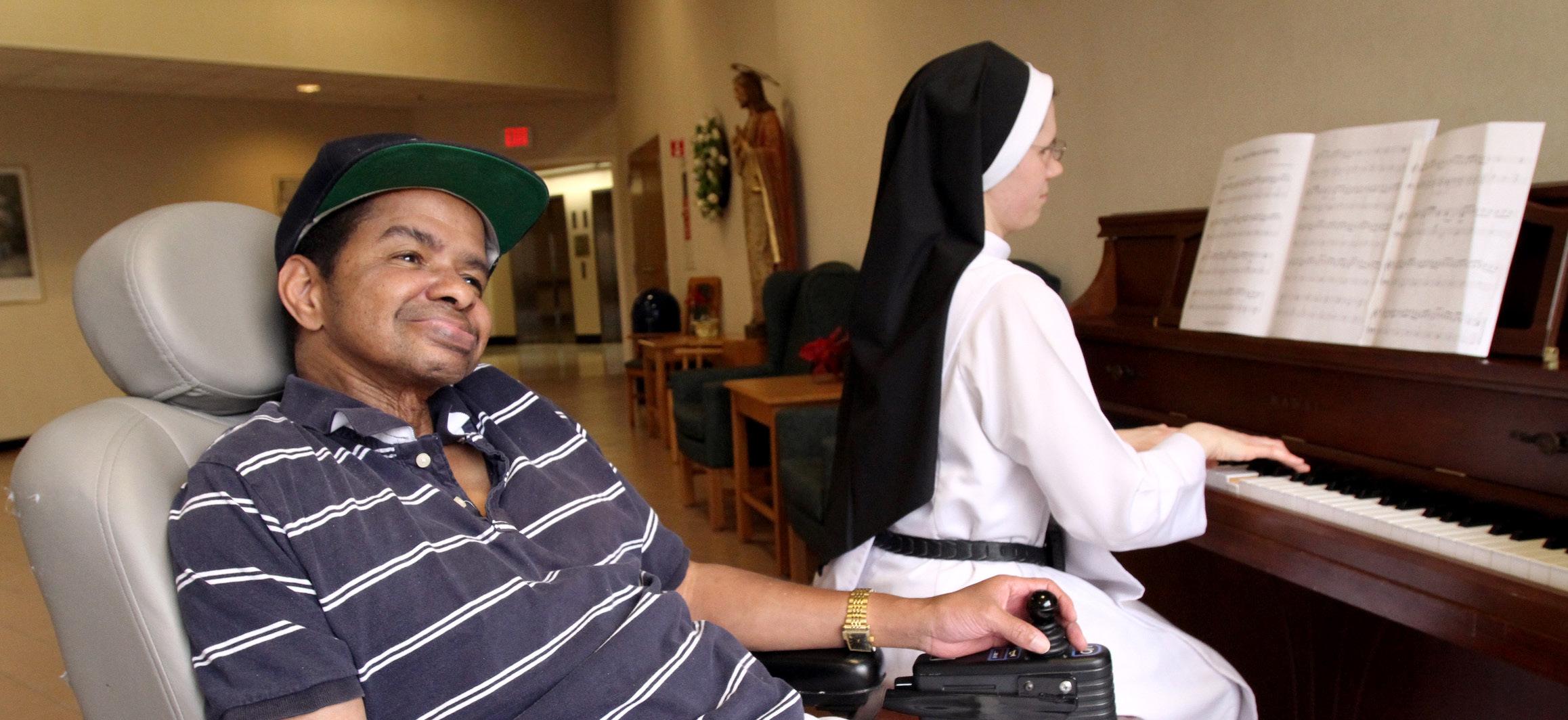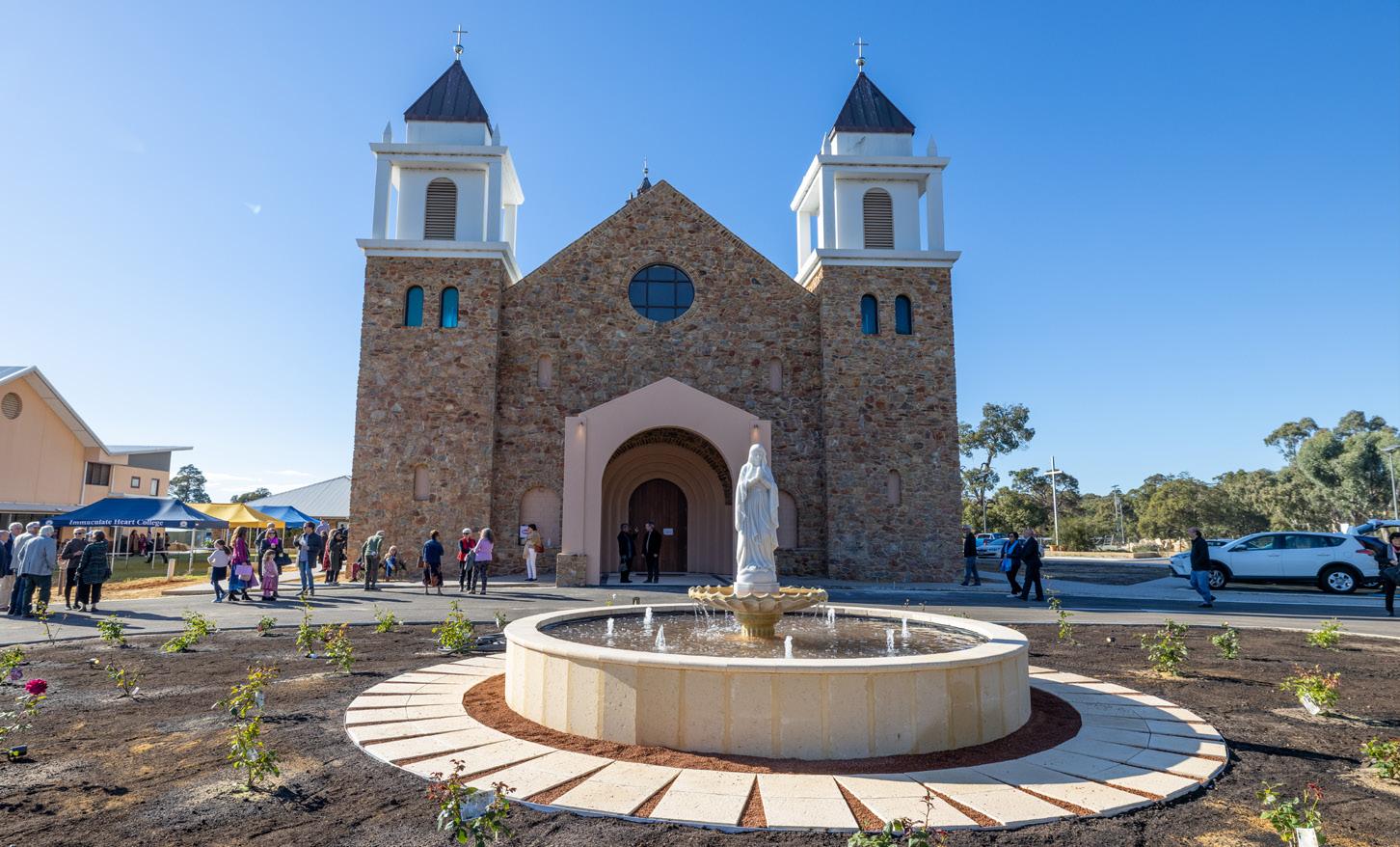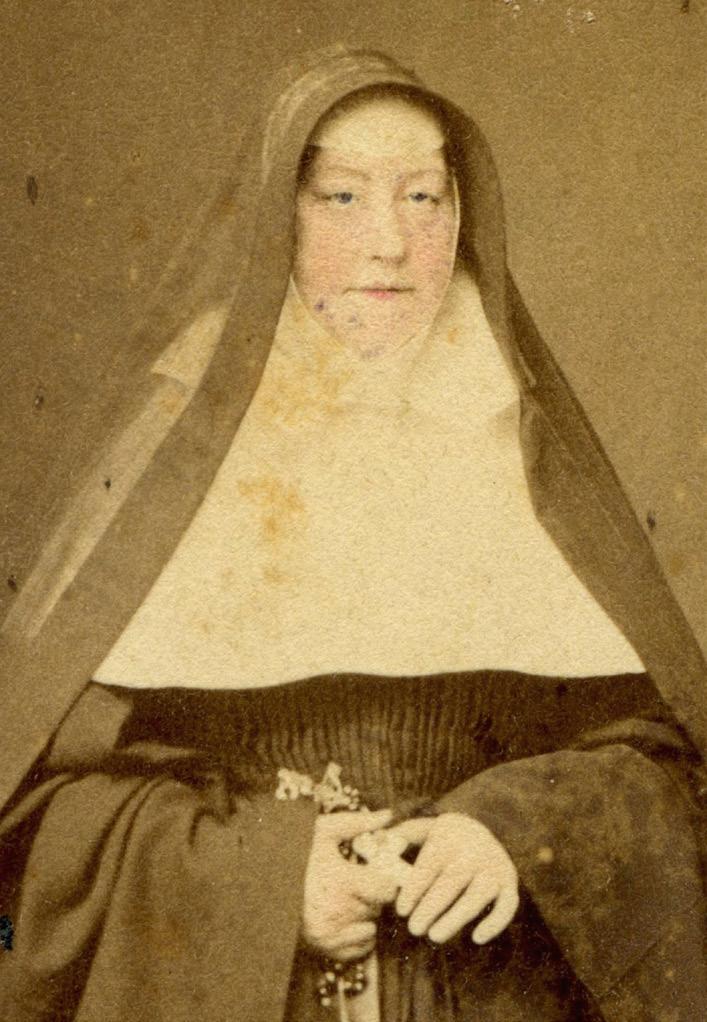





Plenary Council President, Archbishop Timothy Costelloe SDB, spoke from the heart as he delivered his homily at the Perth Closing Mass of the First Assembly on Sunday 10 October, drawing on the richness of the Gospel reading to illustrate Jesus’ desire that we put God first – before the myriad goals that come to occupy so much of our lives, both as individuals and as a Church.
In this Sunday’s Gospel reading, the rich young man, approaches Jesus and puts the question to him, “What must I do to inherit eternal life?”
Archbishop Costelloe explained that even though the young man has faithfully kept the commandments, and his fidelity has truly moved
Jesus to respond to his question with love, “Jesus says some words to him, that I think he’s saying to each one of us as disciples and to the Church in Australia: ‘There is something you lack’.
“All week the Members of the Council have tried, have been trying to identify what it is that we are lacking. What is it that's stopping us from being the Church that the Lord is calling us to be?” he asked.
“For this man, it is his wealth that is the problem. He couldn’t let go, it was just too much. It was a hurdle too high for him to jump and Jesus wasn't offering any way around that hurdle: ‘There is one thing you lack, go and sell everything you own and give the money to the poor and
then come follow Me’”.
“…The central theme of our Plenary Council, if I could sum it up just a couple of words, is letting go,”
Archbishop Costelloe said.
“All three readings, in a way, are about letting go, or perhaps also about letting go in order to let God in. That's what we've been trying to do together this week. And what we will be trying to do, not just as Members of the Plenary Council, but as the whole Church in Australia, over the next nine months leading up to the Second Assembly.”
Archbishop Costelloe continued by explaining that as individuals there will be ambitions, little goals that we have established at the heart of our lives as little gods, and that by doing so, we have pushed the real God out of the way.
“All this week the Members of the Plenary Council have, in a sense, been trying to identify those little goals. And having identified them, we then have to find the courage to let go of them.
“And why?” the Archbishop asked.
“In order to put the real God back where the real God belongs.
“How often, as so many of you have heard me say, almost to the point where I think people might be sick of it - but I’m not sick of it - that the great challenge that we face, is to return to the Church to Jesus Christ and return Jesus Christ to the Church.

Perth Archbishop Timothy Costelloe SDB has this week released an in-depth Pastoral Letter in relation to Voluntary Assisted Dying (VAD).
The Pastoral Letter comes as VAD legislation, passed by the Western Australian State Parliament 18 months ago, will be enacted from Thursday 1 July.
The legislation will mean that a person, under certain specified conditions can access medication which is designed to end their life.
“Important though questions of accessibility to VAD are, there is a more fundamental question of principle. Is it ever ethically permissible to deliberately end one’s own life, to ask another person to help you do so, or to intentionally assist another person to do so?”
Archbishop Costelloe posed in the four-page letter.
Archbishop Costelloe explained that a recent document from the Vatican, ‘Samaritanus Bonus: on the care of persons in the critical and terminal phases of life’, reaffirms the Church’s perennial teaching with respect to the sacredness of human life.
“It has been the constant teaching of the Catholic Church for the last two thousand years that no-one has
the right to end their own life or to deliberately bring about the death of another, with the sole exception of the right of self-defence against an unjust aggressor.
“This conviction about the sanctity and inviolability of human life is one of the most foundational values by which we as Catholics live. We believe that every human life, from its earliest beginnings at conception to its final moments leading to death, is precious and sacrosanct.
“No-one has the right to “step in” and bring to an end a life that has begun under God’s providence and will come to its end under God’s providence,” Archbishop Costelloe continues.
“We also believe, precisely because life is precious and sacred, that it is to be respected at every moment: when the child is still in its mother’s womb, when it grows to be an infant, then a young child, then an adolescent and an adult. We believe that whether a person is sick or well, weak or strong, poor or wealthy, in agreement with us or in opposition to us, educated or illiterate, generous or selfish, faithful or faithless, living or dying, that person is to be treated with dignity
and respect: everything that can be done to give meaning and hope to every person must be done.”
Archbishop Costelloe also highlights the need to support, through prayer and encouragement, all those who are engaged in the healing and caring ministry of the Church.
“Our Catholic hospitals, our Catholic aged-care facilities, our Catholic nursing homes and our Catholic Social Outreach agencies are already committed to being places of compassion, of healing, and of hope.
“With the legalisation of VAD, the witness of all these wonderful institutions to the Catholic understanding of the dignity and sanctity of every human life will become even more important. “It will also become more challenging.”
Read the full Pastoral Letter by Clicking Here : 230621-TC-PastoralLetter-Voluntary-Assisted-DyingWEB-FINAL.pdf (do8h0zazxovw4. cloudfront.net)

An important piece of history in the Archdiocese of Perth unfolded last weekend Sunday 6 June with the Dedication Mass of the new Divine Mercy Church in the parish of GinGin Chittering.
The Romanesque style Church, built thanks to the donations of parishioners and benefactors near and far, was designed by local draftsman Peter Anthes and built by Rodney Naef.
More than 850 people lined the pews and outdoor areas for the two-hour special occasion, on the Solemnity of the Body and Blood of Christ, celebrated by Archbishop Timothy Costelloe SDB.
Speaking during his homily, Archbishop Costelloe, spoke of three thoughts, or gifts, for the congregation to remember.
“The first comes to us from the authority voice of the Church with the Second Vatican Council. When in one of the major documents of that council, Lumen Gentium, the Church Fathers spoke of what the Church is really all about.
“The Church is like a sacrament, that is the Church is a sign and an instrument of two thingscommunion with God and of unity among God's people.
“At the end of each day, if we wanted to examine how our day had gone, we might well ask ourselves, what part did I play today in showing that the Church is all about drawing ever more deeply into communion with God and also drawing ever more deeply into communion especially with my brothers and sisters in the faith,” Archbishop Costelloe asked the congregation.
Archbishop Costelloe continued by speaking about St John Paul II, as the ‘Pope of Divine Mercy.’
“He had one favourite expression that he used over and over again,”
Archbishop Costelloe said.
“He said, ‘The Church is the community of disciples of Christ’.
It’s such a simple idea, and yet again it’s so rich in meaning. The church is a community, not a gathering of isolated, independent people, but a community of people who are disciples of Christ.
“And that means that we as a people know that rather than looking to each other, or only to each other, rather than looking to our own strengths and skills and talents, ultimately, we have to look to Christ.
“Because we are his disciples, we follow him no one else. No one else. No other philosopher, no other
politician, no other leader, we follow Christ and we build our lives on Him. And if this church, this church building, is to fulfill its potential, it will need to be a place where the only person ultimately upon whom we fix our guys, is Jesus himself.”
Joining Archbishop Costelloe for what was his third Dedication Mass in as many as six weeks, was GinGin Chittering Parish Priest Fr Paul Fox, Carlisle Parish Priest Fr Nicholas Perera and Indonesian Catholic Community Chaplain Fr Remi Asnabun together with several other priests from across the Archdiocese.
The next thought, Archbishop Costelloe explained, came from Pope Francis, who referred to the Church as being a field hospital in the middle of a battle.
“Pope Francis went on to say, ‘This is the great mission of the Church today, to be a healer of people's wounds.
“Then he added something - that we need to be not just a healer of people’s wounds, but a warmer of people’s hearts.
“This Church, if it is to fulfill its potential where people can come and find healing of the wounds that are deepest in their lives, certainly, through the sacraments, especially the Sacrament of Reconciliation and the Sacrament of the Eucharist, but also through the community that gathers here.
“We need to be people who both come here for our own wounds to be healed, and come here so that we can help heal the wounds of others.
“Because that after all, is what being a disciple of Christ looks like.”
Speaking at the conclusion of Mass, Fr Paul Fox paid tribute to the many benefactors and parishioners who had contributed to the building of the new Church.

By Sr Joan Smith RSM
In celebration of the 175 anniversary of the Mercy Sisters arrival in Western Australia, Sr Joan Smith RSM gave the following account of their incredible journey at a Mass on 8 January. “Hurrah for foundations: makes old young and young merry.” Catherine McAuley rsm
Today we remember 175th anniversary of the arrival of the Sisters of Mercy in the Swan River Colony.
Six young women, aged between 22 to 41 were passengers on the Barque Elizabeth. Ursula Frayne, Anne Xavier, Catherine, Baptist, Aloysius and Ignatia our pioneer Sisters.
They were part a group of missionaries led by Bishop John Brady which included members of the Benedictines and Spiritan Orders.

After an overnight stay in Fremantle, the Sisters continued their journey on the River to the centre of the colony to find no arrangements had been made for their accommodation. Fortunately, they found rented rooms with a Mrs Crisp who made them welcome. These women became known for their deep faith, their courage and wisdom and their very strong reliance on Divine Providence. Qualities that were woven throughout their mercy service in the Colony.
Their focus was about setting up the ministry of education and very early on the first morning after they arrived, they began their search for a place that would be suitable for both living and beginning a school. A Cottage was found on St Georges Terrace and they signed a rental lease for six months. Within a week, they had prepared the premises for both living and learning. Here they began day classes for children, evening classes for adults and religion classes on Sunday. Shortly after their arrival, Sr Catherine became very ill and died during the last week of their contract.
The small community of Sisters were deeply affected by her death and requested that a few extra weeks to be added to the rental contract.
Their second Cottage in Lord St (now Victoria Avenue) was much smaller and even with their creativity they were unable to reorganise the rooms to continue lessons with the children.
Each day for two years they walked up the hill to a ‘lean to’ attached to the Church. At this time their writings stressed the heat, flies and mosquitoes.
JAMIE O’BRIEN
AMANDA MURTHY
ERIC
MICHELLE
BIBIANA
In August 1847, a very joyful ceremony was held to lay the slabs of the first purpose built Convent/ school and small boarding area on the Victoria Square site. This building, The Holy Cross Convent, is still standing.
It was not until 1871 that the Sisters, now 17 in number, moved into accommodation they could call home. A place where they would share their community and prayer life.
With very few resources, space or comfort, they established an incredible education System. They formed relationships with many groups of people and were particularly caring of the families who had been living in the Colony for 14 years without a priest and therefore Sacraments.
To supplement their funds, they made jam with fruit supplied by a prominent Protestant man. Often the jars, cooling on the window sills, disappeared!
Not everyone appreciated the Sisters. One lady referred to them as Papist women. However on the death of her husband, a doctor in the colony, the Sisters sent her a letter of sympathy and promise of prayers. This letter is conserved in the Collection belonging to that woman’s family.
Ursula boasted one day that a ship never left Fremantle without letters from the Sisters recounting their daily life. They were great communicators and have left us with very detailed information about their life. It is through these letters and many other original hand written records, that we have a privileged glimpse into the reality of the growth of the Sisters’s ministry.
amanda.murthy@perthcatholic.org.au
eric.martin@perthcatholic.org.au
michelle.tan@perthcatholic.org.au
max.hoh@perthcatholic.org.au
bibiana.kwaramba@perthcatholic.org.au

